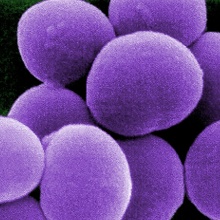It was not until October 2017 that the World Health Organisation WHO sounded the alarm because fewer and fewer effective antibiotics against multi-resistant germs are available. A group led by Professor Bernd Plietker (Institute of Organic Chemistry, University of Stuttgart) has now described in a joint publication*) with researchers working under Professor Friedrich Götz (University of Tübingen) fundamentally new antibiotic structures that could make a significant contribution in the fight against the often fatal pathogenic germs.
An increasing number of germs are being registered worldwide that are able to withstand treatment with the available antibiotics. For this reason the WHO has prioritised the development of new kinds of antibiotics against methicillin-resistant staphylococcus aureus (MRSA). The currently used reserve antibiotics such as, for example, the medicament “vancomycin“ or “teicoplanin“ are frequently based on complex, cyclic peptides and among others inhibit the cell wall biosynthesis, thus the assembly of the bacteria cell wall of so-called gram-positive bacteria. This bacteria group differs from gram-negative bacteria through its cell wall comprising a peptidoglycan and not a lipid layer. However, the number of reports on vancomycin-resistant staphylococcus aureus-stems (VRSA) is also increasing, which is why new strategies and structures are urgently needed to fight gram-positive bacteria.
The scientists from the universities of Stuttgart and Tübingen have now shown that new kinds of non-natural derivates of the class of natural compounds of polycyclic polyprenylated acylphloroglucinols (PPAP) isolated from the orchids of the species clusia rosea are potent antibiotics against multi-resistant pathogens. The non-natural PPAPs show an activity like the stated reserve antibiotics, however do not hinder the cell wall biosynthesis and are, starting from highly available basic chemicals, also available in larger quantities in only few steps.
Very good to excellent activities against seven problem strains and the very slight toxicity towards human cells makes these compounds excellent starting points for the development of further antibiotics. The researchers hope that the future medicaments will be of help for a large number of inflammatory diseases that are problematic in the hospital area, such as, for example pneumonia or meningitis. The work was published in the renowned journal “Applied Chemistry”. It essentially builds on a work that was published in 2011 in the journal “Nature Chemistry“**).
Expert Contact:
Professor Bernd Plietker, University of Stuttgart, Institute of Organic Chemistry, tel. +49-(0)711-685 64283, E-Mail
*) Polycyclic, polyprenylated acylphloroglucinols – a new kind of class of non peptide-based MRSA and VRE-active antibiotics, by Claudia Guttroff, Aslihan Baykal, HuanhuanWang, Peter Popella, Frank Kraus, Nicole Biber, Sophia Krauss, Friedrich Götz and Bernd Plietker, Applied Chemistry 129, 2017, DOI:10.1002/ange.201707069 http://onlinelibrary.wiley.com/doi/10.1002/ange.201707069/abstract;jsessionid=03D95ADC34938106E946F59093166B20.f02t03
**) The total synthesis of hyperpapuanone, hyperibone L, epi-clusianone and oblongifolin A, by Nicole Biber, Katrin Möws and Bernd Plietker, Nature Chemistry, 3, 2011, 938, DOI: 10.1038/nchem.1170 https://www.nature.com/articles/nchem.1170


